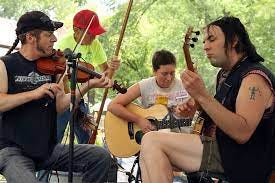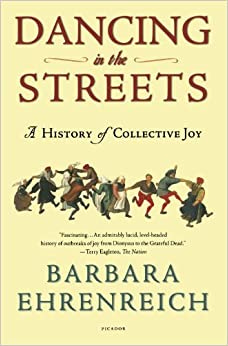In the early 2000s, I saw my first poster for a "Rowdy Square Dance" with the Five Point Rounders in Durham, NC. It made a point of saying "All Genders Welcome." This was new. Since then, I've noticed, and was proud that, old-time and klezmer scenes were on the forefront of gender inclusivity.
So imagine my band's surprise when I said I wanted to host a single-gender only dance. They said “No” before I even had a chance to explain.
Same sex dancing, and gender segregation in general, has been a key part of observant Jewish culture for a long time (although prohibitions usually imply the presence of the thing prohibited, and I wonder sometimes if there wasn’t more mixed gender dancing than we think). In the musical community, it flares up as a topic from time to time, and when it does, me and all the musicians I know groan at the patriarchal prudishness we see in the observant community. I myself have been asked to remove a member of my band once, and I turned down the gig.
But consider this beautiful scene captured in a mere two lines from Vizonsky’s dance manual (1942).
Paatch1 “clapping” Dance
This is a dance for married women only. The object being to inaugurate the young bride into their own circle.
Wow. Those two simple lines demonstrate what we can’t do with an “everyone all the time” inclusion policy. Does that make us bad people?
I read something in Barbara Ehreinrich's excellent "Dancing in the Streets: A History of Collective Joy" that made me think twice about all this. In her introduction, she notices that many early Westerners who studied "primitive” rituals chose to interpret them "as indecent, wanton, and sexual in aim." But, she points out, the sexual aspect of many of these rituals was beside the point and often nonexistent.
What was more common was an ecstasy that involved not just pairs, but the group as a whole.
"Thanks to psychology... we have a rich language describing the emotions drawing one person to another- from the most fleeting sexual attraction, to ego dissolving love, all the way to the destructive force of obsession. What we lack is any way of describing and understanding the "love" that might exist between dozens of people at a time..."
There were attempts. Ehrenreich notes that philosophical ideas like "collective effervesence" and "communitas" have been floated over the last century, but they haven’t stuck. "If homosexual attraction is the 'love that dare not speak its name,' then the love that binds people to the collective has no name to speak at all."
An unnamed need can be dangerous. More so when it is unmet. The vacuum of collective effervesence is currently being exploited by the worst political and media hucksters, who offer cheap fascistic versions of this to confused, alienated young men. The Left, my team, offers a vision of total inclusion as a way to overcome this alienation. This is a huge step forward, but I fear it won’t work.
Complete inclusion works for many things, but it often fails to cohere a group on anything but the most basic of levels. Most of the time that level is “fan of the thing we are all here for” or, in other words, consumer. Indeed, to be welcome in this way is the same as being welcomed to a McDonald's. It is no accident that corporate culture’s model of complete inclusion is identical to the progressive model. And like McDonald’s, it does not satisfy- what we crave is precisely something else.
And so I propose, anxiously, that we bring back single-gender dancing. Of course, no one gets to tell anyone else what gender they are. If you think you fit the bill, that works for me. There is also no particular set of genders that the dances have to be- figure it out for yourself and your community and see if it works. I can imagine a beautiful dance for older people whose genders have merged into a blur of masculine and feminine the way they do in the upper years. Of course, some of the same people who participate in that could also participate in, for example, an all women’s dance, where they would celebrate that community.
The point is restriction. Yes, it has to be restricted! It is, unlike the capitalist marketplace, not for everyone- but we can still be playful. This restrictiveness is absolutely temporary and doesn’t imply any superiority. We don’t have to do it this way every time. We don’t want to duplicate the culture of fundamentalism, we want to borrow what works and throw out what doesn’t. We want to play and see what really actually addresses issues of meaningless and alienation.
Afterword: Yes I know that same gender dances can also be sexual in nature. The idea is that everyone understands the goal of these dances, and therefore self selects for themselves the environment that best accomplishes this. When we have an actual goal in mind, we don’t need to rely on weird authoritarian rules.
Afterafterword: In fact, we don’t even need to fuss with gender at all. Traditional klezmer performances seemed to have moments for individual songs that “went out” to various constituencies: butchers, mother-in-laws, etc. The idea is that people are hungry for affirmation of themselves in ways that differ from corporate culture. Maybe we’d have more success hosting an all inclusive dance and then experimenting with limiting participation on a song or two.
often spelled “Patsch”- credit to Tom A. Deakin for this text.






